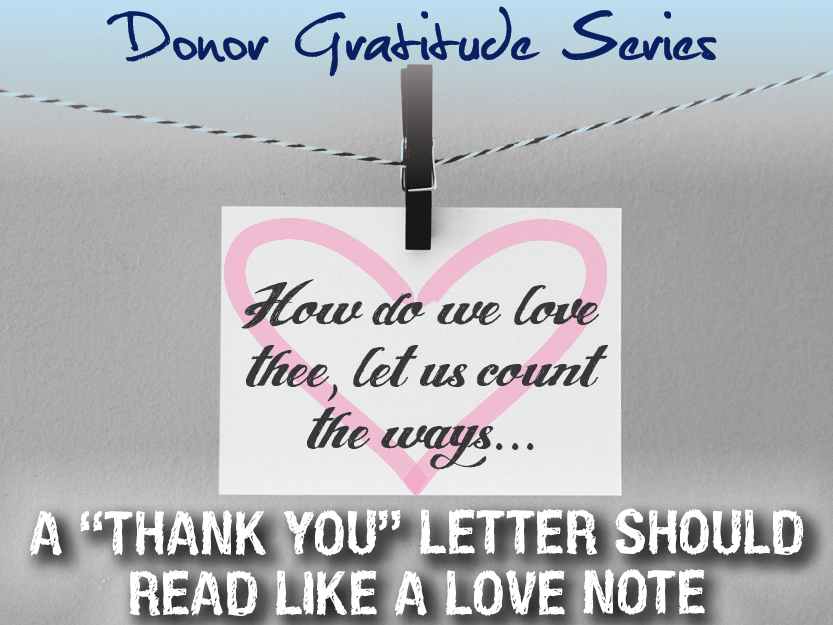Last week, we talked about the ideal “thank you” call… a brief, pleasant surprise that starts the essential work of building relationships with your donors. Like that call, your sincere, personal “thank you” letter is a chance to make sure your donor knows how important they are to your cause. It’s also one of the points at which donors are going to start deciding whether or not they are going to give to you again.
If you’ve been reading this Donor Gratitude Series, you already know these acknowledgement letters mean WAY more than a mere a tax receipt or a pro forma confirmation. You should be saying “thank you” in as many ways as it takes to make your donor feel seen, appreciated, and part of your shared mission.
Here are some strategies for writing an effective and genuine “thank you” letter…
- Send all letters within 48-72 hours of receiving the gift. After allowing for weekends and delivery time, this is the only way to guarantee that your donors receive them within two weeks (10 business days).
- Don’t start with the traditional “thank you” or “on behalf of.” Just like with fundraising appeals, the first line is where you draw your reader in. Here are some examples of strong openers… “Opera has a home in Boston and it’s because of you,” or “A child’s heart was repaired today – you have given her a second chance at life.” And for the love of Penny, make sure your letter is personally addressed, personally signed—none of this “Dear Friend” crap or electronic signatures!
- Thank the donor, not the gift. It’s not what their gift will allow you to do; it’s what they enable you to accomplish. And beware that second paragraph pitfall, where nonprofits often drift into “we-speak.” “We did this…,” “Our programs do that…” Rephrase it. Remember, a thank you is all about “you”—and “you” means your donor.
- Reference the specific gift and its intended purpose. Note any restrictions that the donor wanted placed on the contribution. And tell the donor specifically what you will be able to do because of their generosity. Make sure the impact is connected to the designated purpose of the donation and be as specific as possible.
- Tell your donors when they can expect a progress report on what you’ve accomplished because of their support. And then follow through on sending it when you promised.
- Give your donors the contact info for a real, live person to call/email directly if they need anything at all.
- Do not ask for another gift or anything else (completion of a survey, etc.) in your letter. Do not include a gift envelope.
- Ideally, your letter should come from the top. Think CEO, Executive Director, or Board President. One exception is if the Development Director or another staffer has a strong relationship with the donor. Another exception is if someone receiving services from the organization, a volunteer working your hotline, etc, signs the letter. Have whoever is signing the letter add a handwritten note. If that person is unable, have someone else personalize it.
- Acknowledge past giving (how many years they’ve been giving, if they’ve already given that year, etc.) where appropriate. If you can’t get this language into the letter itself, include it as part of your handwritten note.
- Write for readability. That means—use a serif font for print, and a sans serif for e-mails. Avoid long paragraphs, fancy words, and jargon.
- Direct donors to your website, your Twitter feed, your Instagram—point them to a new resource available there, videos, updates, etc.
I promise you, if you implement these tips, you’ll start noticing all of the bone-dry, bland, and impersonal “thank you” letters you receive from other organizations. With so many other causes clamoring for your donors’ resources and attention, it’s critical that you stand out from the crowd. Writing a stellar, heartfelt “thank you” letter is one of the most meaningful ways for you to distinguish yourself.
Lastly, if you really want to nerd out on donor acknowledgement letters, check out a study released by the Philanthropy Centre last month. It’s called Learning to Say Thank You: The Role of Donor Acknowledgements and you can download it here.



